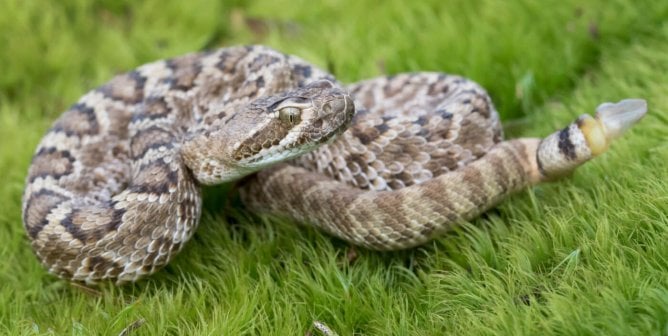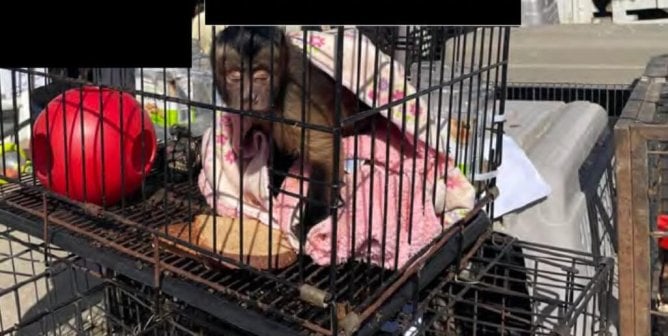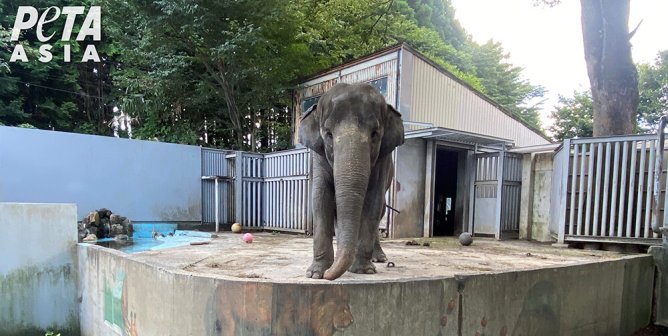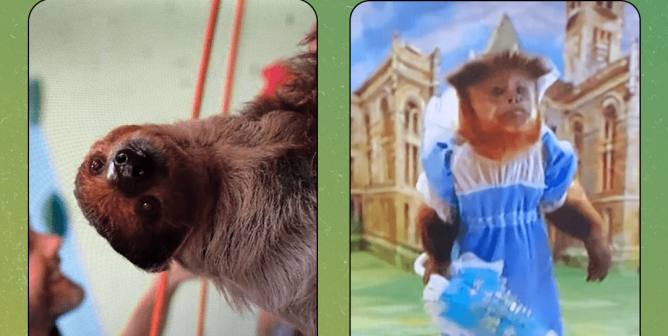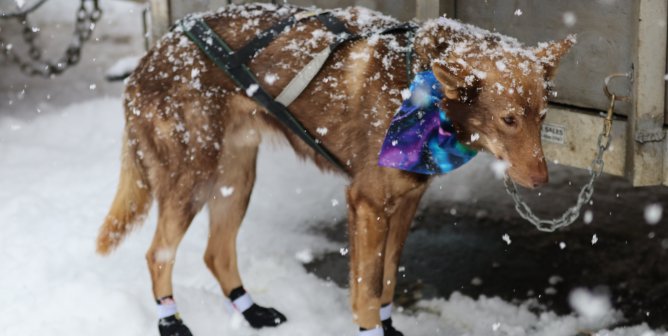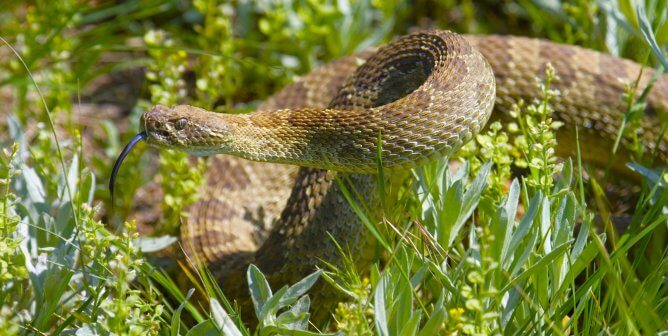Animal Actors: Involuntary Performers
Human fascination with and affection for exotic animals unfortunately makes them popular subjects for advertisers and the film and TV industry. Performing elephants and “smiling” chimpanzees may grab our attention, but these animals are not willing participants in the entertainment industry.
Problems With Using Wild Animals
Using wild animals such as bears, snakes, big cats, monkeys, wolves, and elephants for entertainment is inherently cruel, and there is never a situation in which it’s acceptable to use them in a movie or on a TV show. No amount of training can ever completely override their natural instincts. In nature, most animals do everything that they can to avoid humans, but those used by Hollywood trainers are forced into close proximity with their captors and are also deprived of their families, their freedom, and everything else that’s natural and important to them.
PETA’s undercover investigations and law-enforcement probes into animal suppliers for the film and TV industries have documented that animals are whipped and kept in deplorable conditions. The anguish for most of these animals begins shortly after birth, when they’re separated from their mothers and denied the maternal care that they need for normal development. This can result in extreme physical and psychological distress. As wild animals mature and become useless to trainers, many are discarded at seedy roadside zoos and other substandard facilities, where they may suffer for years without proper food or veterinary care.
It’s important to note that chimpanzees are no longer used in films. But that chimpanzee “grin” so often seen in movies and on TV is actually a grimace of fear or a carefully choreographed response to a command. In order to force them to perform, trainers often beat young chimpanzees with their fists, clubs, or even broom handles. Shock devices were also used. This systematic pattern of abuse and dominance caused the animals to be constantly anxious and fearful, always anticipating the next blow. Apes were routinely beaten into submission and forced to pantomime human behaviors that are foreign and confusing. When primatologist Sarah Baeckler conducted a 14-month undercover investigation of prominent Hollywood training facility Amazing Animal Actors, she “saw a lot of physical violence. A lot of punching and kicking, and the use of the ‘ugly stick,’ a sawed-off broom handle, to beat the chimps” and “all kinds of physical abuse to keep them paying attention and in line with the trainer.”1
The inappropriate use of wild animals in film and advertising can cause public misconceptions about the species. A survey of patrons at the Lincoln Park Zoo found that those who thought that chimpanzees were not endangered assumed so because the animals are commonly seen on TV and in movies.2
Problems With Using Domesticated Animals
Dogs, cats, and other domesticated animals are at risk because they can be easily and cheaply replaced. Disney faced calls to drop distribution plans for its film Snow Buddies when 15 puppies used in the production got sick and some died.3 Many of the dozens of puppies were shipped to the Canadian production company from an unlicensed commercial breeder in New York at 6 weeks of age rather than at 8 weeks as required by federal law. The use of purebred dogs in movies such as 101 Dalmatians and Beverly Hills Chihuahua, in TV shows such as Frasier and in commercials such as those for Taco Bell have caused a jump in the popularity of certain breeds, yet very few people investigate the traits and needs of the breed of dog that they are purchasing. When people realize how difficult Dalmatians can be to train, for example, or that deafness is common in the breed, rescue groups and shelters become flooded with them.
Horses are easily spooked and susceptible to heat exhaustion. Because of the potential for injury, horses should never be forced or coerced into performing in scenes that involve racing, loud noise, fire, high speeds, elevated platforms, or stunts in which they are required to trip or roll. Despite the AHA’s monitoring of the 2005 film Flicka, one horse broke her neck after reportedly becoming entangled in a rope, and a second horse was euthanized after breaking his leg in a similar incident.4 A bull in a cattle drive scene in the 2003 film The Rundown suffered a broken neck when his horns became caught in the ground, and a horse in the 2001 film American Outlaws died after breaking away from a herd and becoming impaled on a hitching post.5
A PETA eyewitness investigation of Birds & Animals Unlimited led to a complaint filed with the USDA for alleged violations of the federal Animal Welfare Act involving inadequate shelter, nutrition and veterinary treatment for dogs, cats and others.6 For more on this case, please visit PETA.org.
‘No Animals Were Harmed …’
That familiar statement that scrolls up the screen at the end of a film is no guarantee that animals were not exploited, hurt, or even killed during production. For example, even though shock collars and BB guns were used to train horses for a film called Running Free and a horse died on the set of Simpatico, both productions received the AHA’s blessing.7 The Los Angeles–based group, formed after a horse was deliberately thrown to his death for the 1939 film Jesse James, is not adequately staffed to monitor all productions effectively, nor does it have the authority to enforce its own standards. The AHA is funded by the Screen Actors Guild, which means that it is paid by the industry that it monitors.
The AHA bases its ratings only on the short period of time when animals are on the set—it supervises animals only during filming, not when they are being trained for films. The director of the AHA’s Film and Television Unit, Karen Rosa, told the Los Angeles Times, “We’re a non-profit. We’re not staffed to do that kind of comprehensive oversight …. To make the assumption that when they leave the set they will treat the animals differently is not something we do.”8
In addition to not monitoring preproduction training or living conditions, the AHA does not take into account a trainer’s animal-related offenses or violations of the federal Animal Welfare Act. For example, Predators in Action was hired to provide the grizzly bear (who later mauled his trainer) for the movie Semi-Pro, even though the company had been previously cited by the USDA for animal welfare violations that included failing to maintain structures and shelters in good repair, keeping a lion in a tiny shelter box in the snow, and failing to provide animals with drinking water. The AHA allowed Evan Almighty producers to use Birds & Animals Unlimited, an animal supplier warned repeatedly by the USDA for its failure to comply with veterinary care, sheltering, and caging requirements. Furthermore, no agency monitors separation of babies from their mothers, and the AHA doesn’t take into consideration living conditions or the disposal of animals after they are no longer of use to the exhibitor.
What You Can Do
While some filmmakers and TV producers understand that animals aren’t ours to abuse for entertainment, many still need to be persuaded—and that’s where viewers come in. By avoiding shows and movies that use animals, the public can send a powerful message to Hollywood that profits won’t come without principles and that we expect them to keep animals out of their projects. PETA encourages compassionate viewers to take the fight to the industry and post their disapproval about the use of animals in a production on the social media pages of the director, the network, and the production company.
And while chimpanzees are not forced to perform for film anymore, Hallmark uses demeaning, clownish images of chimpanzees on its greeting cards. Chimpanzees are currently at risk of extinction—wild populations are dwindling because of habitat loss and the illegal pet trade. Just like Hollywood productions, greeting cards featuring great apes dressed in silly costumes and making funny faces promote disrespect for them and mislead the public into believing that they’re prevalent in nature when, in fact, they’re endangered. Urge Hallmark to join top stock-image agencies like Getty Images, Shutterstock, and Dreamstime in banning unnatural images of primates.
Finally, if you see animals being used on a film or TV set or at a training compound can report it here, contact our confidential whistleblower hotline at 323-210-2233, or send an e-mail to [email protected].
References
1Rachel Abramowitz, “‘Every Which Way But Abuse’ Should Be Motto,” Los Angeles Times 27 Aug. 2008.
2S.R. Ross et al., “Inappropriate Use and Portrayal of Chimpanzees,” Science 314 (2008): 1487.
3Jeanette Walls, “PETA Not Monkeying Around With ‘Speed Racer,’” MSNBC.com, 11 Jul. 2007.
4CBSnews.com, “Horses Died on Set of Flicka,” 24 Oct. 2006.
5Associated Press, “Second Horse Killed During ‘Flicka’ Filming,” 29 Apr. 2005.
6Gary Baum,”A Dead Kangaroo, a Bleeding Pig: Hollywood’s Top Animal Training Firm Hit With PETA Abuse Claims (Exclusive),” The Hollywood Reporter, 11 Jan 2017.
7James Bates and Ralph Frammolino, “Questions Raised About Group That Watches Out for Animals in Movies,” Los Angeles Times 9 Feb. 2001.
8Abramowitz.
